 Add Review
Add Review Subscribe
Subscribe Nominate
Nominate Submit Media
Submit Media RSS
RSS
Version 0.3: How not to make a dungeon crawler
 NTC3
NTC3- 04/21/2018 03:16 PM
- 1072 views
Delve is a dungeon crawler game by Subzero_Dragon that’s currently in version 0.3 and hasn’t been updated since 2015 (while the developer himself was last seen in 2016), which is one reason I feel comfortable breaking my usual rule on reviewing demos and giving it a score. Another is that an unrated review wouldn’t do justice to the current state of the game.
Storyline
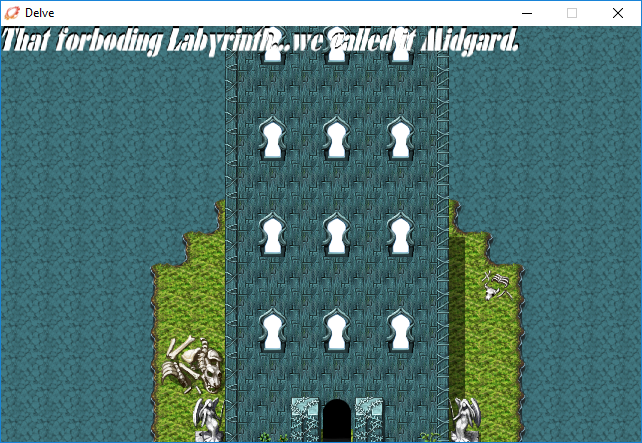
Intro. I like how there are clearly visible windows in this image, but none are present once you get inside.
The starting point of a typical dungeon crawler is a dungeon, protagonist(s) who must crawl it, and in all but the most hardcore varieties there’s some nearby town to serve their needs. Unlike a more involved work like Soul Sunder (which had a prologue setting out main character’s backstory, amongst other things), Delve generally sticks with these bare bones: there’s a tower you ascend (even though you are still asked to “delve deeper” in it) that’s called Midgard for some reason unconnected with Norse mythology, and a town named Labrys that literally has nothing in it but the Guildmaster’s House where you get quests, the combined armor/weapons/item shop, an Inn to recover, a crafting recipe/material shop, and a (currently closed) Pub. Obviously, none of the merchants are even remotely developed into anything resembling characters.
The game page tells you about a band of seven playable characters, but you’ll be using just the first one, named Will by default, with a second, Maya, appearing at the very end. The only real dialogue is at the start with the Guildmaster and with Maya at the end, and a lot of it is simply drawn out exposition and such. It still has weird moments like the Guildmaster saying your character must go through a test to get the explorer’s license because too many explorers die in the dungeon, which makes sense…except that the test is to go there anyway, and kill the first boss, located on the fifth floor, thus making it utterly pointless. Then, Maya has total amnesia, because of course she does, and has lines like “You are weird…. I meant that as a compliment. I like people who think for themselves.”
Aesthetics (art, design and sound)
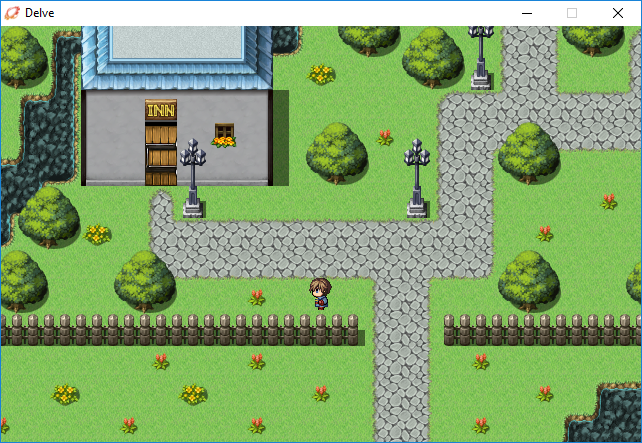
Example of town mapping. This completely unnotable road actually transitions you right outside Midgard; one would expect it to be a little grander, with guards, signs and what not.
The on-map graphics are VX Ace RTP, but the menu is a rather prettier (though at times less functional) Luna Engine. The few town NPCs use default facesets, but the main character busts are custom; as you can see above, though, that’s not really much of a strength. The soundtrack is RTP and the packs to it, and it does its job fine. Sound effects are also RTP, and the only notable thing there is that slimes’ attacking you produces default punch sounds, somehow. As for the mapping, it’s fine in the town, and I suppose the fifth floor boss level is not too bad either. However, levels 1-4 are all randomly generated, apparently through Neonblack’s script. I am not sure whether it’s the fault of the script or the way creator used it, but as someone who likes roguelikes enough to have finished NetHack, I can confidently say the result is a disaster.
Gameplay
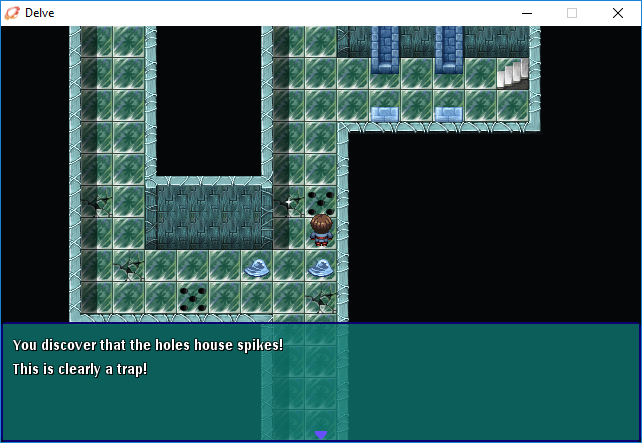
The screenshot above could have come from any of those four levels. They are all just occasionally intersecting two-tile corridors, where you’ll only ever see the following things: wall tile, wall column tile, regular floor tile, cracked floor tile, “ore” tile you can mine with a pickaxe, spiked floor tile, staircase up, staircase down, chest, blue slime and fast-moving green slime (standing for elite “Slime Queen”). The only thing that changes at all is that Slime numbers increase, to the point there are dozens of them on level 4, and perhaps there are slightly more chests as well. Moreover, while spikes are clearly visible and self-explanatory (even though the first time you see one such tile, your character doesn't recognize them, and has to throw a rock at them to realise what they are), the cracked tiles actually do not do anything. I suppose that’s a relief, given that in horror games like Mystery Dorm, walking onto one collapsed the floor and insta-killed you. Instead, though, Delve has falling rock traps, which are not visible on the map at all. In fact, the first time I played it, 4 rocks unpredictably fell onto my character’s head before he ever fought anyone, dealing from 33 to 85 HP damage, thus quickly halving his health, initially at 485 HP.
Now, here’s a further aside to explain why these traps don’t work. After all, rock traps were present in my beloved NetHack, too, and there, you couldn’t really see them coming either (unless you levelled up high enough to get a warning intrinsic.) However, you could reduce the damage they dealt to almost nothing by simply wearing a metal helmet – a detail Delve obviously lacks. Most importantly, though, these traps WERE marked on the map after you triggered them (or another creature did, which won’t happen in Delveeither). Here, you are apparently supposed to remember which one of the utterly identical floor tiles, out of dozens present in a single corridor, is the trap one. Moreover, the spiked tiles generally deal way LESS damage then the falling rock ones; when I had to walk through them, due to the level generation absolutely not caring whether or not you get a clear path, I first got 4 damage, then 28, then 32; meanwhile, I was usually lucky to get ~35 damage from a falling rock instead of 70-90.
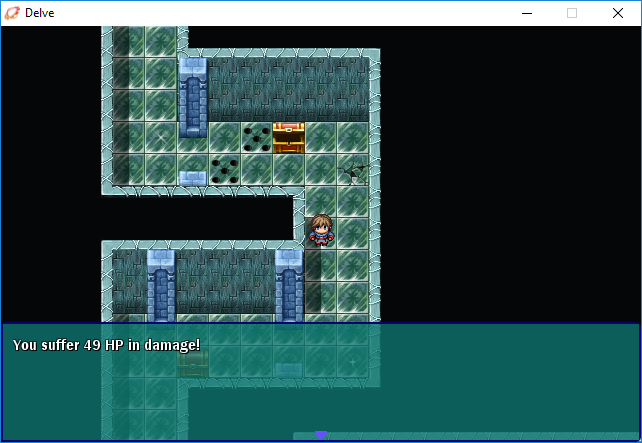
That screenshot shows two spikes behind the character, completely blocking the way; there’s no diagonal movement to let you bypass them, in case you were wondering. Moreover, afterwards you get two rocks traps in a row, one of which just hit the character, separated by just a single tile.
The combat is no better than the dungeon “exploration”. The only encounters you ever get are a single Slime, two Slimes, or a Slime Queen. There’s no variety to these battles either. You start with no skills, and while there’s a separate “Learn Skills” menu that steadily grows with every level you get, none of them actually seem to be obtainable. Equally, the slimes just attack, (they do have a chance of knocking you unconscious for one or several rounds, which only seemed to trigger when there were two of them.) The Slime Queen has a 6-attack combo alongside a normal attack, but is mainly notable for being a huge damage sponge. The flower boss on level 5 actually has a decent variety of attacks (it has a normal attack, triple one, a vampiric one, and the ability to put either or both characters to sleep, which you have no way of curing.) but by that point I was long past caring.
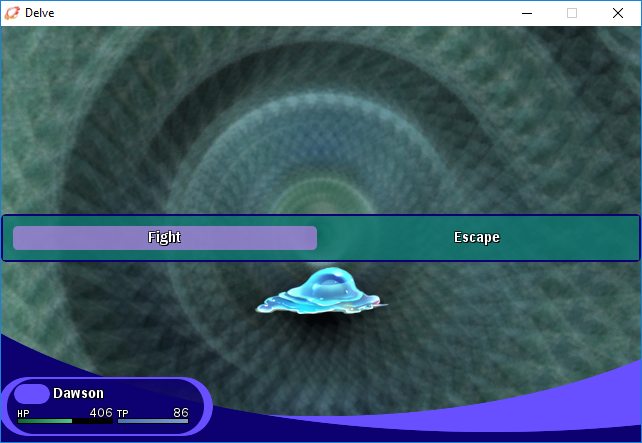
Prepare to see this a lot. Since the levels all look the same, even the background won't ever noticeably change.
I should note that the game lets you switch between the initial Warrior, magical Elementalist, Barbarian and Martial Artists classes at any time, though they gain experience separately. After seeing that you can’t learn skills, and Barbarian has the greatest health, I switched to it, and stayed there. You can also change the difficulty in the menu from easy, to normal to Heroic to Hard, but I discovered that every single time you save, the difficulty defaults back to easy. Eventually, I got tired of resisting game’s attempts to select the right path for me, and let it stay there: after all, the only thing high difficulty does is buff enemies’ stats several times and make the game into even more of a chore. (I did switch to Hard to fight the flower boss to see if it can be done; Easy had it die within the first turn; Hard rendered Maya’s attacks useless and lasted for quite a while, eating through some 10 healing Salves.) Saving works at any time; however, the option to do so is buried within the custom menu under all the other stuff, and you have to actively scroll down in order to find it. At first, I assumed the game used checkpoints somewhere in Midgard, died, and had to view the unskippable intro again.
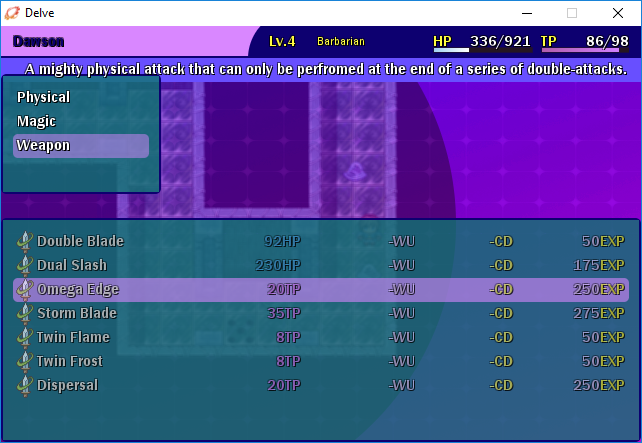
Skills Barbarian can theoretically get at level 4. All are greyed out and unusable.
Now, the only thing left to talk about is the game’s “economy”. The item shop can sell either the default rubbish for any class or the next step up; Warrior’s only advantage over Barbarian is the ability to wear Plate Armor and Chain Helms over Bronze. You can also get healing salves, revival Phoenix’s Mints (very expensive, and also useless with just one character), a Card to teleport back to town from Midgard and a pickaxe for mining ores. Said mining, and the subsequent crafting is the only way to go from initial Long Sword to Bastard Sword; buying weapons normally is impossible. Don’t even think about looting them either: the only things dungeon chests have are either plain money, or Catalysts, which are not used for any crafting recipes, and so are just pure 150 coin tokens as well. Getting a bunch of them (easy, since dungeon floors get recreated every time you re-enter them from outside, respawning the chests) will soon allow you to buy everything valuable in the game. Then, you’ll have the Alchemy Book to convert ingredients you get from killing Slimes into healing Salves or Phoenix Mints (still worth making, as you can then sell them for 750 gold), and the two books required for weapon-making; that of smelting and that of forging.
As in, once you actually get started mining (and assuming your pickaxe doesn’t break on the first try: saving beforehand might be a good idea), you’ll obtain Iron Ore or (wait for it) Steel Ore, which will make anyone with even basic knowledge of metalworking or geology or history of weaponry, or anything else related to this, laugh very hard. It’s bad from the gameplay perspective, too, as it means Iron Ore should always be sold at the first opportunity, since you can’t do anything else with it besides turning it into the crappiest weapons, ones equivalent to what you already have. It would have been so much better if you could obtain coal instead, and then smelt it alongside Iron to get steel. After all, right now you already have to mine the ore, then smelt two ores into one ingot (where the smelting book comes in), and then turn two ingots into a weapon. It may not even be a bad system, but there’s just too little available content to justify it, and it doesn’t come remotely close to justify the actual process.
Conclusion
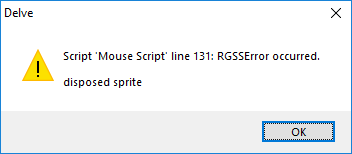
While Delve is mostly stable for a demo game (the bug above only happens occasionally when you exit to title), it has practically no other advantages. Subzero_Dragon may eventually come back to it and make it into a better game; his subsequent collaborations with Craze during Swap in the Middle with You event were substantially superior, after all. Doing so would clearly require adding far more content to it from the start to justify the random generation, refine that same algorithm to create actually interesting levels, and rework or outright remove the goddamn rock traps. Up until that happens, it’s best to leave it well alone.
Storyline

Intro. I like how there are clearly visible windows in this image, but none are present once you get inside.
The starting point of a typical dungeon crawler is a dungeon, protagonist(s) who must crawl it, and in all but the most hardcore varieties there’s some nearby town to serve their needs. Unlike a more involved work like Soul Sunder (which had a prologue setting out main character’s backstory, amongst other things), Delve generally sticks with these bare bones: there’s a tower you ascend (even though you are still asked to “delve deeper” in it) that’s called Midgard for some reason unconnected with Norse mythology, and a town named Labrys that literally has nothing in it but the Guildmaster’s House where you get quests, the combined armor/weapons/item shop, an Inn to recover, a crafting recipe/material shop, and a (currently closed) Pub. Obviously, none of the merchants are even remotely developed into anything resembling characters.
The game page tells you about a band of seven playable characters, but you’ll be using just the first one, named Will by default, with a second, Maya, appearing at the very end. The only real dialogue is at the start with the Guildmaster and with Maya at the end, and a lot of it is simply drawn out exposition and such. It still has weird moments like the Guildmaster saying your character must go through a test to get the explorer’s license because too many explorers die in the dungeon, which makes sense…except that the test is to go there anyway, and kill the first boss, located on the fifth floor, thus making it utterly pointless. Then, Maya has total amnesia, because of course she does, and has lines like “You are weird…. I meant that as a compliment. I like people who think for themselves.”
Aesthetics (art, design and sound)

Example of town mapping. This completely unnotable road actually transitions you right outside Midgard; one would expect it to be a little grander, with guards, signs and what not.
The on-map graphics are VX Ace RTP, but the menu is a rather prettier (though at times less functional) Luna Engine. The few town NPCs use default facesets, but the main character busts are custom; as you can see above, though, that’s not really much of a strength. The soundtrack is RTP and the packs to it, and it does its job fine. Sound effects are also RTP, and the only notable thing there is that slimes’ attacking you produces default punch sounds, somehow. As for the mapping, it’s fine in the town, and I suppose the fifth floor boss level is not too bad either. However, levels 1-4 are all randomly generated, apparently through Neonblack’s script. I am not sure whether it’s the fault of the script or the way creator used it, but as someone who likes roguelikes enough to have finished NetHack, I can confidently say the result is a disaster.
Gameplay

The screenshot above could have come from any of those four levels. They are all just occasionally intersecting two-tile corridors, where you’ll only ever see the following things: wall tile, wall column tile, regular floor tile, cracked floor tile, “ore” tile you can mine with a pickaxe, spiked floor tile, staircase up, staircase down, chest, blue slime and fast-moving green slime (standing for elite “Slime Queen”). The only thing that changes at all is that Slime numbers increase, to the point there are dozens of them on level 4, and perhaps there are slightly more chests as well. Moreover, while spikes are clearly visible and self-explanatory (even though the first time you see one such tile, your character doesn't recognize them, and has to throw a rock at them to realise what they are), the cracked tiles actually do not do anything. I suppose that’s a relief, given that in horror games like Mystery Dorm, walking onto one collapsed the floor and insta-killed you. Instead, though, Delve has falling rock traps, which are not visible on the map at all. In fact, the first time I played it, 4 rocks unpredictably fell onto my character’s head before he ever fought anyone, dealing from 33 to 85 HP damage, thus quickly halving his health, initially at 485 HP.
Now, here’s a further aside to explain why these traps don’t work. After all, rock traps were present in my beloved NetHack, too, and there, you couldn’t really see them coming either (unless you levelled up high enough to get a warning intrinsic.) However, you could reduce the damage they dealt to almost nothing by simply wearing a metal helmet – a detail Delve obviously lacks. Most importantly, though, these traps WERE marked on the map after you triggered them (or another creature did, which won’t happen in Delveeither). Here, you are apparently supposed to remember which one of the utterly identical floor tiles, out of dozens present in a single corridor, is the trap one. Moreover, the spiked tiles generally deal way LESS damage then the falling rock ones; when I had to walk through them, due to the level generation absolutely not caring whether or not you get a clear path, I first got 4 damage, then 28, then 32; meanwhile, I was usually lucky to get ~35 damage from a falling rock instead of 70-90.

That screenshot shows two spikes behind the character, completely blocking the way; there’s no diagonal movement to let you bypass them, in case you were wondering. Moreover, afterwards you get two rocks traps in a row, one of which just hit the character, separated by just a single tile.
The combat is no better than the dungeon “exploration”. The only encounters you ever get are a single Slime, two Slimes, or a Slime Queen. There’s no variety to these battles either. You start with no skills, and while there’s a separate “Learn Skills” menu that steadily grows with every level you get, none of them actually seem to be obtainable. Equally, the slimes just attack, (they do have a chance of knocking you unconscious for one or several rounds, which only seemed to trigger when there were two of them.) The Slime Queen has a 6-attack combo alongside a normal attack, but is mainly notable for being a huge damage sponge. The flower boss on level 5 actually has a decent variety of attacks (it has a normal attack, triple one, a vampiric one, and the ability to put either or both characters to sleep, which you have no way of curing.) but by that point I was long past caring.

Prepare to see this a lot. Since the levels all look the same, even the background won't ever noticeably change.
I should note that the game lets you switch between the initial Warrior, magical Elementalist, Barbarian and Martial Artists classes at any time, though they gain experience separately. After seeing that you can’t learn skills, and Barbarian has the greatest health, I switched to it, and stayed there. You can also change the difficulty in the menu from easy, to normal to Heroic to Hard, but I discovered that every single time you save, the difficulty defaults back to easy. Eventually, I got tired of resisting game’s attempts to select the right path for me, and let it stay there: after all, the only thing high difficulty does is buff enemies’ stats several times and make the game into even more of a chore. (I did switch to Hard to fight the flower boss to see if it can be done; Easy had it die within the first turn; Hard rendered Maya’s attacks useless and lasted for quite a while, eating through some 10 healing Salves.) Saving works at any time; however, the option to do so is buried within the custom menu under all the other stuff, and you have to actively scroll down in order to find it. At first, I assumed the game used checkpoints somewhere in Midgard, died, and had to view the unskippable intro again.

Skills Barbarian can theoretically get at level 4. All are greyed out and unusable.
Now, the only thing left to talk about is the game’s “economy”. The item shop can sell either the default rubbish for any class or the next step up; Warrior’s only advantage over Barbarian is the ability to wear Plate Armor and Chain Helms over Bronze. You can also get healing salves, revival Phoenix’s Mints (very expensive, and also useless with just one character), a Card to teleport back to town from Midgard and a pickaxe for mining ores. Said mining, and the subsequent crafting is the only way to go from initial Long Sword to Bastard Sword; buying weapons normally is impossible. Don’t even think about looting them either: the only things dungeon chests have are either plain money, or Catalysts, which are not used for any crafting recipes, and so are just pure 150 coin tokens as well. Getting a bunch of them (easy, since dungeon floors get recreated every time you re-enter them from outside, respawning the chests) will soon allow you to buy everything valuable in the game. Then, you’ll have the Alchemy Book to convert ingredients you get from killing Slimes into healing Salves or Phoenix Mints (still worth making, as you can then sell them for 750 gold), and the two books required for weapon-making; that of smelting and that of forging.
As in, once you actually get started mining (and assuming your pickaxe doesn’t break on the first try: saving beforehand might be a good idea), you’ll obtain Iron Ore or (wait for it) Steel Ore, which will make anyone with even basic knowledge of metalworking or geology or history of weaponry, or anything else related to this, laugh very hard. It’s bad from the gameplay perspective, too, as it means Iron Ore should always be sold at the first opportunity, since you can’t do anything else with it besides turning it into the crappiest weapons, ones equivalent to what you already have. It would have been so much better if you could obtain coal instead, and then smelt it alongside Iron to get steel. After all, right now you already have to mine the ore, then smelt two ores into one ingot (where the smelting book comes in), and then turn two ingots into a weapon. It may not even be a bad system, but there’s just too little available content to justify it, and it doesn’t come remotely close to justify the actual process.
Conclusion

While Delve is mostly stable for a demo game (the bug above only happens occasionally when you exit to title), it has practically no other advantages. Subzero_Dragon may eventually come back to it and make it into a better game; his subsequent collaborations with Craze during Swap in the Middle with You event were substantially superior, after all. Doing so would clearly require adding far more content to it from the start to justify the random generation, refine that same algorithm to create actually interesting levels, and rework or outright remove the goddamn rock traps. Up until that happens, it’s best to leave it well alone.

Posts 

Pages:
1
Pages:
1












